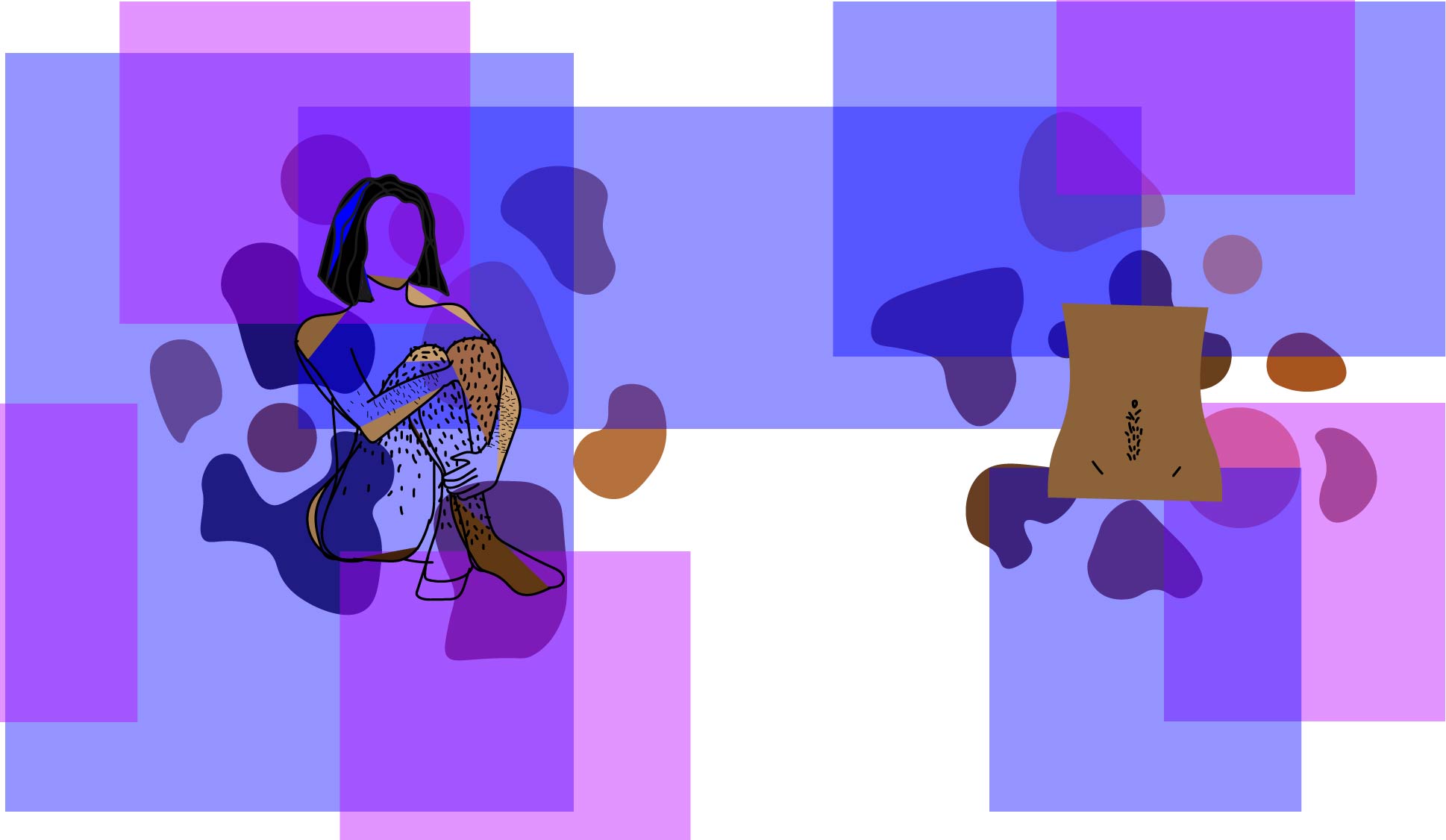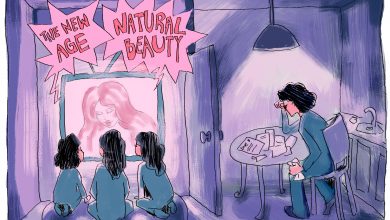The Masculinization of Body Hair

Image Description: On the left, a faceless person sits with their legs crossed, hair noticeably covering their forearms and legs. On the right is a closeup of a hairy human torso. Behind both images are overlapping blue and purple rectangles.
At twelve years old, I began to wish I was hairless. I remember searching through my mother’s bedroom, feverishly fumbling through beauty organizers until I found the sacred item — a razor. I had no idea how to use it. Hesitantly, I dragged the blade across my upper lip, watching the peach fuzz fall. Cuts and scratches began to emerge on my skin, but at the time, being hairless was more valuable than protecting my face. I was taught that beauty requires pain, and shaving became a means for me to feel beautiful.
Shaving at such a young age might sound extreme, however, it is a reality that many women —especially women of color— experience.
The beauty standard of hair removal traces back to the late 19th century. Darwin’s evolutionary theory linked body hair to “primitive” ancestry and “less developed forms.” Researchers began to consider a clear contrast between the hairiness of men and the hairlessness of women to be a sign of higher anthropological development in a race. Women who had thicker and darker hair were seen as belonging to an inferior race while women who had lighter, minimal hair were seen as belonging to a superior one.
As the beauty standard of hairlessness developed over centuries, women of color’s hair —which is often naturally thicker and darker — became synonymous with genetic inferiority. This racialized beauty norm allowed white women to separate themselves from women of color. White women who had naturally lighter body hair and the financial means for hair removal were able to reach a higher standard of beauty and social hierarchy than Black and brown women. This in turn masculinized women of color.
The masculinization of women means that they are seen as having male characteristics, including male sexual characteristics. Masculinizing women has been used as a justification for behavior without analyzing women’s behavior in the context of female experiences and structural locations. Women who have masculine traits are perceived as abnormal and unnatural.
Women of color have been repeatedly masculinized throughout history. For instance, the term “woman” was originally only reserved for white women, not women of color. Women with lighter skin have been regarded as kinder, gentler, delicate, and more attractive since the origins of slavery in the United States. These characteristics are socially connected to femininity.
The link between femme-presenting people with lighter complexions to feminine and positive traits has been strengthened by the media. In movies and television, the actors who play feminine and desirable characters are most often white women, then light-skinned women of color. Women with lighter skin tones receive more media attention and can achieve greater levels of success. In contrast, femme-presenting people with darker-skin tones are masculinized in the media, actively preventing them from the same opportunities for fame and recognition.
Society’s expectation of hairlessness further masculinizes people of color. While body hair is still largely seen as unfeminine, people of color’s body hair is considered more manly in comparison to white people’s body hair. The effect of this racialized misconception is worsened mental health. Beauty standards surrounding body hair can lower women’s self-esteem levels and increase anxiety. The effect these standards have on mental health is compounded for women of color. Women of color are conditioned to believe that their body hair opposes the beauty standards, so they then internalize the idea that they themselves oppose the beauty standard and are therefore unfeminine and undesirable.
The pressure to remove body hair is also rooted in pedophilia. Femme-presenting people are told to have hairless bodies, baby-soft skin — all features that children, not adults, naturally have. Child-like physical features are sexualized, forcing women to try and look as young as possible.
Like many other women of color, I viewed my visible body hair as a point of concern. My hair felt inherently masculine, even though it is natural regardless of gender. Because hairlessness is associated with attractiveness and femininity, removing my body hair was more worthwhile than any con to shaving. Many women see hair removal as essential, even though the practice itself is unpleasant.
Getting rid of unwanted hair is not an enjoyable process — all forms of hair removal are physically painful. “Tame” forms of hair removal, like shaving and plucking, can lead to skin damage, irritation, and scarring. Other forms, such as laser hair removal and hair removal treatments, can lead to eye injuries, skin infections, and chemical burns. Removing hair is not only painful, it is expensive as well. In the Atlantic article The Casualties Of Women’s War on Body Hair, Nadine Ajaka writes, “Women who shave will spend over $10,000 on hair removal throughout their lifetime. Women who wax will spend over $23,000.” Even though hair removal is costly and irritating, over 99 percent of women remove their body hair.
While women lose time and money removing their body hair, men gain profit. In the book Plucked: A History of Hair Removal, Rebeca M. Herzig explains how the hair removal industry is male-dominated and the manufacturers for packaged depilatories (a cream or lotion that removes body hair) have been mainly men, even though women have more experience with depilatories. As women continue to buy methods of hair removal, men receive structural power from their purchases. When Eurocentric beauty standards equate hairlessness with attractiveness and desirability, femme-presenting people consider hair removal as a necessity for beauty — no matter the cost.
In recent years, however, conversations about body hair have both increased and changed. Hair-positivity feminist movements are pushing for people to embrace and grow out their body hair. These feminist movements are centered around cisgender white women — they are able to have body hair without facing the same level of scrunity as others. The choice to not remove body hair is not the same for everyone, doing so causes harm for minority groups.
For trans and nobinary people, not shaving your body hair can lead to abuse. When trans women do not shave their body hair, they frequently experience acts of violence because people see them as “men pretending to be women.” Trandgender people who choose to keep their body hair are nonconforming against gender roles, which subjects them to bullying and other forms of hate. Hair removal can be gender affirming for trans and nonbinary femme people, but it is also centered around a pressure for femme-presenting people to be hairless and conform to Eurocentric beauty standards.
People of color are also hurt by choosing to not remove their body hair. If people of color choose not to remove their body hair, it unfortunately reinforces harmful stereotypes such as “Dirty Arab” and “Smelly Indian.” This leads to racialized violence.
Societal standards of beauty idealize white physical features and hairless bodies, which means women of color with body hair are not considered conventionally attractive. Beauty has power; a woman’s value often comes from her looks and similar superficial qualities. For example, conventionally attractive women receive higher incomes because of their beauty. Hairy Black and brown women do not fit into society’s warped idea of beauty, potentially lowering their income and undermining their ability to advance in professional settings. For minority groups who are disproportionately harmed with regards to their body hair, resisting body hair standards is not always an option.
Beauty inevitably helps determine a woman’s opportunity to succeed throughout life. While female beauty is meant to be subjective, it is measured in society by proximity to whiteness and hairlessness. Black and brown hair is constantly seen as ugly, pressuring women of color to configure their bodies so that they cater to Eurocentric beauty standards.
Although I know that body hair does not determine beauty or worth, I still shave almost daily, unable to see hair removal as anything other than a necessity to my beauty routine. Unlearning the social norms revolving around hairlessness is a difficult process because they have been ingrained in me since childhood. When women are taught that their value is derived from appearance, being hairless is yet another way to try and reach society’s unattainable beauty standards.




